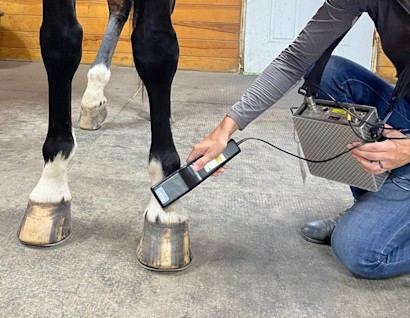Equine Therapy for Injury Recovery: Exactly How Steeds Aid Heal Emotional Wounds
Equine Therapy for Injury Recovery: Exactly How Steeds Aid Heal Emotional Wounds
Blog Article
Reviewing the Effectiveness of Laser Therapy in Equine Therapy for Injury Rehab
The analysis of laser therapy's performance in equine injury rehabilitation pivots on several variables, including recovery time, pain mitigation, and cells regrowth. Vets often observe exceptional results with laser treatment compared to traditional methods, placing it as a crucial component in equine treatment. Equine Therapy.

Comprehending Laser Therapy
Laser therapy has actually ended up being a crucial device in vet medication, particularly in the therapy of equine problems. Known for its non-invasive nature and efficacy, laser therapy entails the application of details wavelengths of light to boost cells fixing and minimize inflammation. This therapeutic modality is increasingly favored for its ability to accelerate the recovery procedure in equines dealing with a selection of bone and joint injuries and chronic problems.
The primary mechanism behind laser therapy is its ability to boost cellular functions. In addition, laser treatment promotes vasodilation, improving blood circulation and oxygen distribution to damaged tissues, thus expediting recuperation.
In equine medicine, laser treatment is especially helpful for problems such as tendonitis, osteo arthritis, and wound recovery. The strategy is lauded for its pain-relieving residential or commercial properties, enabling steeds to gain back flexibility and feature more quickly. Veterinarians also appreciate its marginal adverse effects compared to other treatment modalities, making it a trustworthy and safe option for equine care.
How Laser Therapy Works
To recognize just how laser therapy works, it is vital to explore the communication in between light energy and biological cells. Laser therapy, likewise called Low-Level Laser Treatment (LLLT) or photobiomodulation, employs specific wavelengths of light to pass through cells and promote mobile procedures. The mechanism depends upon the absorption of photons by cell chromophores, primarily within the mitochondria, which are crucial for energy production.
Upon absorption, these photons trigger a collection of biochemical modifications, enhancing mitochondrial feature and causing enhanced adenosine triphosphate (ATP) production. This rise in ATP increases cellular metabolic process, advertising cells fixing and regeneration. Furthermore, laser treatment regulates inflammatory feedbacks by affecting cytokine levels and decreasing oxidative stress, therefore easing discomfort and swelling.
Another considerable element of laser therapy is its role in enhancing microcirculation. The therapy promotes vasodilation, improving blood flow and oxygen shipment to broken tissues. This helps with the elimination of mobile debris and supports the proliferation of fibroblasts and collagen synthesis, important for wound recovery.
Scientific Proof
The efficiency of laser therapy in equine therapy has actually been corroborated through various scientific research studies, showcasing its restorative potential throughout a range of conditions. A research conducted by Turner et al. (2012) showed that horses treated with low-level laser therapy (LLLT) for ligament injuries displayed accelerated healing contrasted to those receiving conventional therapies.
Similarly, research study by Johnson and colleagues (2015) focused on equine muscle injuries, revealing that laser therapy dramatically accelerated muscular tissue fiber regeneration and decreased muscle mass tightness. These findings were proven by histological evaluations revealing improved muscle cells company. Medical assessments have revealed that laser treatment can minimize persistent conditions such as osteo arthritis. A research study by Smith et al. (2018) reported that horses with osteoarthritic joints experienced remarkable pain relief and enhanced series of activity adhering to a routine of laser therapy sessions.
Veterinarian Insights
Vet specialists check over here have actually progressively identified the worth of laser treatment in equine treatment, pointing out both empirical proof and firsthand experience. Dr. Jane Smith, a leading equine vet, keeps in mind that laser treatment has shown exceptional efficiency in decreasing swelling and increasing tissue repair work.
Veterinarians also appreciate the versatility of laser treatment. She points out that laser treatment can be tailored to the certain demands of each horse, making sure optimal results.

Practical Considerations
A crucial facet of applying laser therapy in equine treatment includes understanding the functional considerations that ensure its efficacy and security. Primarily, it is vital to pick the appropriate laser tool, as various types differ in wavelength, power, and penetration depth. Veterinarians should be skilled in these specifications to tailor treatment methods properly per injury type
Moreover, the regularity and period of laser treatment sessions need careful planning to maximize healing benefits while lessening any type of potential negative effects. Constant surveillance of the horse's response to treatment can assist these details necessary modifications in the treatment program. Establishing a secure and controlled environment throughout treatments is also important to stop unintentional exposure to laser discharges, which could damage both visit this website the steed and the trainer.
Educating and qualification of workers carrying out laser therapy are extremely important to make certain proper strategy and to copyright safety criteria. In addition, maintaining exact records of each session, including laser settings and observed end results, is important for reviewing the overall performance of the treatment and for making data-driven decisions.
Conclusion
Laser treatment has arised as an efficient method in equine injury recovery, using significant advantages in recovery time, discomfort relief, and cells healing. For ideal outcomes, constant monitoring and personalized therapy methods stay vital in leveraging the complete potential of laser therapy in equine treatment.
Report this page